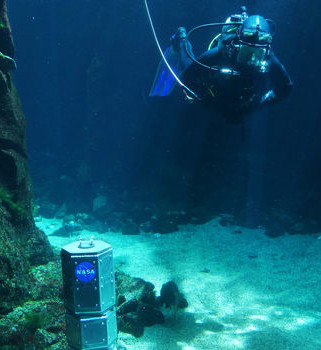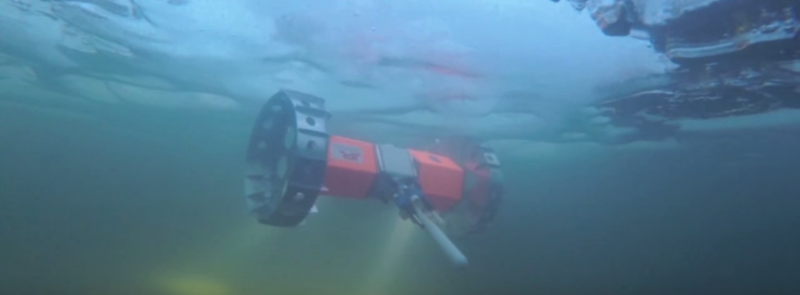NASA’s Jet Propulsion Laboratory (JPL) is working on a robot for the exploration of Europa’s oceans. A big problem is the oceans are under a permanent ice ceiling. JPL is making that ceiling a feature with a robot that dances, okay wheels, on the ceiling.
The Buoyant Rover for Under-Ice Exploration (BRUIE) is, as the name says, buoyant so it floats against the ice ceiling. Two large paddle wheels allow it to drive along the ceiling.

In 2012 they took an earlier version to Barrow, Alaska for testing under the ice. While the temperatures encountered there may not match those of Europa’s frozen methane [Europa is water, also – Rud] it’s still a challenging environment for man and robot. One of the challenges for the arctic exploration team was the need to test when the ice was thin enough to make a hole. They had to proceed judiciously to avoid falling in.
Recently they tested a newer version rover the California Science Center aquarium, giving new meaning to the phrase “swimming with the fishes.” Andy Klesh, principal investigator for the rover at JPL and volunteer diver at the science center accompanied BRUIE during the testing. Sometime in the future they hope to turn BRUIE loose in a lake where it can explore autonomously.
Fortunately the arctic team didn’t encounter any polar bears, another possible risk. When the rover makes it to Europa it’s unlikely to encounter an extra-terrestrial equivalent.
Video coverage after the break.















Interesting start but liquid methane is a hell of a lot different than liquid water.
A journey of a thousand miles begins with a single step, you got to start somewhere, and iterate. Making something work between -162 °C and −182.5 °C on Europa can’t be much harder than making a machine work on the polar regions of Mars at −143 °C
Europa’s oceans are water you’re thinking of titan which is a moon of Saturn while Europa is a moon of Jupiter
LOL, thanks – I failed to check.
An RTG seems perfect for this application. It could provide internal heating to where electronics can operate, and would have a large temperature differential for the thermoelectric part. As long as you can prevent the methane from boiling on contact, which would reduce thermal conductivity and increase temperature even more. And there would be an issue with cooling the RTG long enough to get it in the methane ocean. I take it back, maybe an RTG is not the answer.
When I first heard about this, I think that was one of the problems they were considering. The simple heat given off by the probe would boil the methane around it, disrupting the sensors. Last I heard they were mulling the idea of running the electronics in cycles. Shut almost everything off. Let it cool. Start it back up, with the most sensitive instruments first, then the more robust sensors, and run until the bubbles cause problems. Then shut down. repeat as needed.
Europa’s oceans are water you’re thinking about titan
Added a note. Got confused with the methane seeps they saw in the Arctic.
Methane from organic sources is what they hope to find. I can find no mention of it making up any major part of Europa frozen or liquid (boiling point of Methane -162 °C, and its melting point is −182.5 °C).
The surface temperature of Europa goes from −223°C to -148.15°C with an average of −171.15°C so if there is Methane from an inorganic source on the surface it could be in any of the three states.
If they are making robots designed top operate at really low temperatures. It would be great to see them incorporate some high temperature superconductors.
If they are travelling in liquid water under the surface of Europa, 0°C is not cold enough as far as I know for any of the high temperature superconductors. Maybe on Titan with its lakes Methane and rocky mountains of ice.
Had me puzzled… I couldn’t figured out why NASA would be studying “Europe’s frozen oceans.” Europa! Now it makes sense.
Under water ice might be a reasonable environment for a robot.
I wonder why they didn’t choose 4 (or 3) wheels over 2? I get the impression this design would require more energy to keep it moving/balanced/and the lights facing the correct way.
because at the end of the day once they get to Europa they’ll going to have to put this thing down a mile plus deep hole. so making the robot a two wheeled robot means it can more efficiently fit down the hole and so be larger and hold more equipment.
Hm. I think Europa’s ice is likely few kilometers thick, so it is going to be difficult to lower this puppy into the ocean. It should work once there, though.
A nice big RTG can get the probe to melt through at a reasonable speed and at the same time supply power for the probe…or if NASA manages to get the permits (not likely) to send an actual nuclear reactor, which could generate stupid amounts of heat…
From what we know about drilling though very thick ice, is that the high pressures cause it to form very large crystals (>1m), which are very difficult to drill through…
And if slow enough it would probably allow a tether to unwind.
One problem is only de-ionized or distilled water allows RF to penetrate it, other than that is is a fantastic attenuator of RF.
A tether to a RF transmitter on the the surface from an underwater base station that uses ultrasound might work nicely. How much would a few kilometers of copper wire weigh, with a nice Polytetrafluoroethylene coating ? I think that the pressure would be too great for deploying relays as it sank, they would be crushed once the water refroze around them. I wonder is how efficient ultrasound would be at travelling through a few kilometers of ice. You could use spread spectrum ultrasound and large forward error correction … *ponder* It is probably the kind of thing that you could only test (cheaply) in the Antarctic or Arctic (you could even do initial tests at the surface using two boreholes a few kilometers apart).